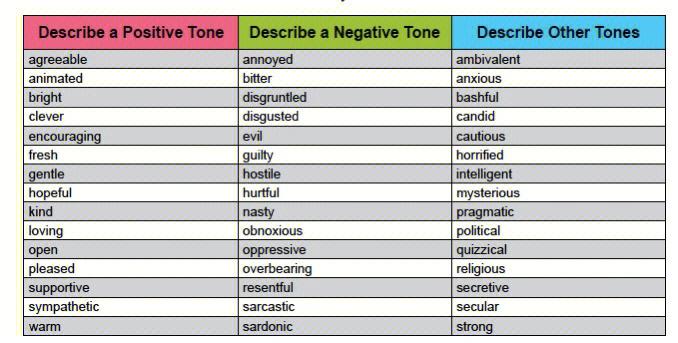Different Types of Tones in Writing
Writing is an art form that can convey a wide range of emotions and messages. One of the key elements that can greatly impact the effectiveness of your writing is the tone. The tone you choose can shape how your readers perceive your message, whether it’s professional, persuasive, or personal. In this article, we will delve into the various types of tones in writing, their characteristics, and when to use them.
Informal Tone
An informal tone is characterized by a relaxed and friendly style. It’s often used in personal correspondence, social media posts, and casual conversations. This tone is conversational and can include slang, contractions, and colloquial expressions. Here are some examples of an informal tone:
| Formal Sentence | Informal Sentence |
|---|---|
| I would like to schedule a meeting with you. | I wanna set up a meet-up with you. |
| Could you please send me the report by the end of the day? | Can you shoot me that report by the end of the day, please? |
When to use an informal tone: Use an informal tone when you want to create a friendly and approachable atmosphere, such as in personal emails, social media, or casual conversations.
Formal Tone

A formal tone is characterized by a dignified and respectful style. It’s often used in professional settings, academic papers, and formal correspondence. This tone is precise and avoids slang, contractions, and colloquial expressions. Here are some examples of a formal tone:
| Formal Sentence | Informal Sentence |
|---|---|
| I would like to request a leave of absence for two weeks. | I need to take a two-week break. |
| It is imperative that the project be completed by the deadline. | The project has to be done by the deadline. |
When to use a formal tone: Use a formal tone when you want to convey professionalism, respect, and authority, such as in business letters, academic papers, or formal presentations.
Objective Tone

An objective tone is characterized by a neutral and unbiased style. It’s often used in scientific writing, research papers, and news reporting. This tone focuses on facts and avoids personal opinions or emotional language. Here are some examples of an objective tone:
| Objective Sentence | Subjective Sentence |
|---|---|
| The experiment was conducted on a sample size of 100 participants. | The experiment was a success, as the results were impressive. |
| The report highlights the key findings of the study. | The report provides valuable insights into the subject matter. |
When to use an objective tone: Use an objective tone when you want to present information in a factual and unbiased manner, such as in scientific papers, research reports, or news articles.
Persuasive Tone
A persuasive tone is characterized by a compelling and convincing style. It’s often used in advertising, marketing, and persuasive essays. This tone aims to persuade the reader to agree with the writer’s viewpoint or take a specific action. Here are some examples of a persuasive tone:
| Persuasive Sentence | Neutral Sentence |
|---|---|
| Investing in renewable energy is crucial for a sustainable future. | Renewable energy is an option for a sustainable future. |
| By purchasing this product, you will experience unparalleled quality and satisfaction. | This product offers quality and satisfaction. |
When to use a persuasive tone: Use a persuasive







